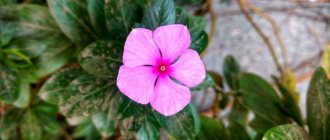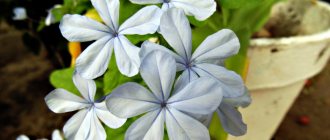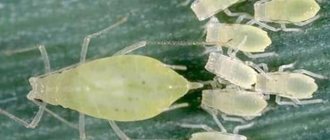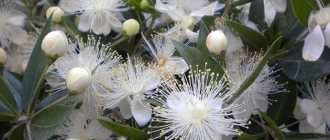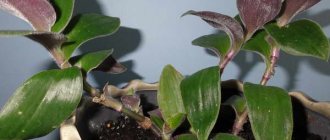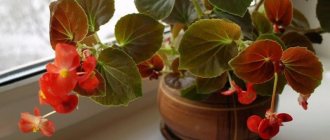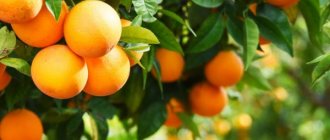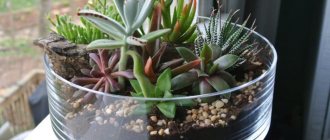Aucuba, or “golden tree,” is an exotic plant that has been attracting tourists from East Asia for many years. When the opportunity arose to export the female plant from Japan after it bore fruit, people realized that Aucuba was a dicotyledonous plant. In order for the plant to begin to spread throughout the world, a male bush was required.
It is a hardy subtropical plant that can survive even in the deep shade of a forest. There are eight species found in China, Japan, Korea and the Himalayas. An evergreen shrub with red flowers has been adapted for growing indoors. The most popular species is the Japanese aucuba.
Aucuba, with yellow spots on its leathery leaves, is a typically green shrub reaching 3-4 meters in height. During flowering, the plant displays small, inconspicuous flowers with panicles that are usually reddish or purple. The growth is lush, increasing annually by 15-20 cm in length. A potted perennial can have a lifespan of 10 years or more.
| In one season the plant reaches a height of 15-20 cm. |
| It blooms in summer and can also bloom in winter if it is very humid. |
| Blooms in spring with small red flowers. |
| Perennial. |
Aucuba japonica: useful, but poisonous
There is nothing outstanding in the flowering But the fruits - red juicy berries - look very beautiful on the bush.
As scientists have found, aucuba juice contains active substances: aucubin, aucubigenin and shikimic acid, thanks to which the plant releases volatile substances into the air that have antiviral, antifungal and antibacterial activity.
So the original shrub, originally from the land of the rising sun, can not only decorate your home, but also provide first aid for injuries, cuts, and insect bites.
Crushed leaves and fruits are used for treatment Carefully! To use Japanese aucuba as a remedy, you need to know the exact dosages and first consult with your doctor. The tissues of the plant contain toxic substances.
Medicinal properties
Bouvardia flower: home care and methods of propagation
The aucuba plant is not only beautiful in appearance. The foliage contains active substances that bring incredible benefits to both humans and the environment:
- Destruction of harmful bacteria and microorganisms in the room,
- Regulation of air microflora to the required levels,
- A quick helper for people with injuries and burns, tumors and frostbite.
- Creating a peaceful and warm atmosphere at home.
Note! All parts of the flower are poisonous, therefore, when creating a recipe, you must strictly adhere to the recommended proportions.
Popular varieties of Japanese aucuba (with photos)
In indoor floriculture, only two types of aucuba are grown: Japanese aucuba and Himalayan aucuba. Of these, gardeners like Japanese Aucuba so much that breeders have taken care of the variety of varieties of this species.
Variegata - with large leaves and golden specks scattered across them.
GoldDast – yellow color predominates on the leaves, with green inclusions.
Dentata - with jagged edges on green, pointed leaves.
Hillieri - with narrow green monochromatic leaves with sparse teeth.
Picturata - leaves with a bright yellow core and dark green edges with yellow spots.
Description of the plant
Aucuba is an evergreen plant with large leathery leaves collected in a bunch. In natural conditions of existence (subtropical forests) these are ornamental trees and shrubs. In various sources it is classified as the dogwood or garriaceae family; some biologists distinguish it as the genus of aucubaceae.
The golden spots on the leaves make the flower especially attractive. Thanks to these original spots, it received its second name - golden tree. This indoor plant is quite unpretentious; growing and caring for it will not require special knowledge and will not take much time.
Temperature and watering
It is advisable for the golden tree to overwinter at temperatures from 8°C to 10-12°C. If these indicators increase by just a few degrees, the plant may shed its leaves.
Watering in winter should be reduced to a minimum. Aucuba is not too moisture-loving; it will more easily tolerate the relative dryness of an earthen clod than waterlogging (because of this, black spots may appear on the foliage).
Read about caring for Tradescantia in your home garden.
If your home is favored by myrtle, take note of these simple rules for caring for it.
Know more about begonia https://sad-doma.net/houseplants/dekarativnotsvetushhie/begoniya/rodina-begonii.html and the homeland of this amazing plant.
Difference from Croton
Reference. Aucuba is very similar to another plant species - croton. Without serious knowledge of botany, some of their species can be confused - this often happens.
But even an amateur can understand the difference by the following signs:
- dying leaves of aucuba turn black, and those of croton turn yellow;
- Aucuba has opposite leaves, Croton has alternate leaves;
- During the flowering period, these plants are easy to distinguish - unlike aucuba, croton blooms with tassels similar to mimosa.
Pruning, replanting, propagation
In March, before the start of the period of active growth, the aucuba bush needs to be “beautified.” Pinch off the tops of the shoots, trying to form a beautiful shape.
The cuttings that remain after pruning can be rooted in damp sand and then transplanted into separate containers - this is how aucuba propagates easily.
Well, to get seeds , you need to have two plants of different sexes in the house and perform artificial pollination: aucuba is a dioecious plant.
The soil for the golden tree should consist in equal parts of:
- turf land;
- leaf soil;
- peat;
- sand;
- humus.
Be careful when replanting the plant. Remember that the roots of Japanese aucuba are quite brittle.
Can I keep it at home?
Aucuba has long been actively used in oriental medicine. The leaves of the plant help with:
- burns;
- frostbite;
They can also be applied to wounds and bruises to reduce pain, disinfect and speed up healing. Plant-based drugs are used to treat gastrointestinal diseases.
Remember that domestic aucuba is dangerous due to its poisonous leaves, flowers and berries. You need to make sure that children do not touch the flower.
If possible, place the pot with the plant higher where the child cannot reach. Talk to your children and explain the dangers. After working with a flower (planting, pruning), you must wash your hands thoroughly with soap. The entry of plant juice into the stomach (intestines) causes inflammation and bloody diarrhea.
Diseases and problems
If the basic rules of care are violated, the aucuba may acquire such signs.
- reduction of variegation due to lack of light;
- thinning of shoots due to lack of feeding;
- drying of leaf tips due to dry air and lack of watering;
- loss of brightness of leaf color in too bright light.
Aucuba is affected by: spider mites, scale insects, thrips and scale insects. If pests are found, treat the plant with an appropriate insecticide.
Features of growing at home. Briefly
Aucuba is undemanding in domestic conditions. However, this plant still requires some care:
| Temperature | The plant feels comfortable in cool conditions, the optimal temperature is 20°C, no more, and in winter from 5 to 10°C. |
| Humidity | Average. It does not suffer from dry air, but spraying will not be superfluous, especially in winter when the heating system is running. |
| Lighting | The plant needs diffused light. |
| Irrigation | Moderation in the soil is very important. Once a week in summer and once every two weeks in winter. Let the soil dry out between waterings. |
| The soil | Plants grow best in light soil. |
| Application of fertilizers and fertilizers | You can purchase organic, mineral, and granular fertilizers. Apply once every 3-4 months from spring to late summer. |
| Transfer | If the plants are young, apply the treatment once every 1-2 years in the spring. For adults, reduce the frequency to once every 2-3 years. |
| Spreading | There are 2 main methods - propagation by cuttings and propagation by seeds, but growth occurs much more slowly. |
| Special cultivation characteristics | To make it comfortable for the plant to grow and bloom indoors, in the summer you can take the pot with aucuba outside. He is able to live even in smoky air. You should also prune regularly. |
And a little history
For a long time, the Japanese prohibited the export of this tree from their country, protecting it almost as a national treasure. Only in the 17th century. one traveler miraculously managed to bring it to England. The aucuba took root, blossomed and bore fruit, but, of course, there were no seeds in the fruits. The tree was female.
And only a few decades later, the British botanist Fortune brought a “couple” from Japan - he, as a specialist, could not make a mistake! Since then aucuba has finally spread to Europe. Still, the beauty created by nature should belong to all people!
And for the most curious, we suggest you watch a video about the Japanese Aucuba
Folk signs
The Japanese have long noticed that aucuba has magical properties. This amazing flower helps to improve family relationships. In a house where there is a flowerpot with an evergreen tree, everyone takes care of each other, treats each other with respect and love.
Even guests who find themselves in a warm, friendly atmosphere become more cheerful and kinder. And the negativity brought from outside is immediately blocked by the sausage tree.
Be sure to get yourself a golden bush. This will bring you happiness and wealth. And if the admirer behaves indecisively, not daring to propose, give him a flowerpot with aucuba. He will immediately gain courage, you will get married, and live happily ever after.
Pests
The main pests of aucuba are aphids, spider mites and scale insects.
To deal with these nasty insects, follow the following procedure:
- Separate the diseased plant from the rest into a quarantine zone. By the way, you must also endure quarantine the first time a new green friend appears in your home. A week will be enough: during this time you will be able to identify whether the plant has larvae or adults of dangerous pests or signs of diseases that are dangerous to others.
- Select adult insects with your hands, then wash the plant in a warm shower using green or tar soap. Cover the pot with polyethylene to prevent soap from getting into the soil. Thoroughly wipe each leaf on both sides and the stem with a cotton cloth soaked in soapy water.
- Treat the indoor plant with a suitable chemical preparation: Fitoverm, Trichopolum, Actofit, Fufanon, Strela, Jaguar. If the degree of damage is small, you can try folk remedies. This is a tincture of tobacco, potato tops, onion peels, a decoction of wood ash and liquid soap.
Care
Soil and fertilizers
When selecting soil, remember two important conditions: airiness and looseness. This can be achieved by mixing sand, leaf, sod-clay and peat soil in a ratio of 1:2:6:1. Second option: humus, peat, leaf and turf soil, sand, in a ratio of 1:1:2:1:1. Don’t forget to heat the prepared mixture in the oven or keep it in the freezer for a day - this will protect your plants from pests and infections.
Aucuba survives wintering well in open ground, but only in southern regions with mild winters.
Illumination
Aucuba loves bright but diffused light, so shade the window with light tulle curtains or a paper screen.
It is especially important not to forget about this if your aucuba has settled on the windowsill of a south window. Do not place a flower pot in direct midday sun - it will burn the tender leaves
But this applies to varieties with yellow spots on the leaves.
Plants with a normal green color live quietly almost anywhere in the room. During the cloudy winter months, be sure to purchase a lamp for additional illumination. On warm days, give your pet air baths on the balcony or street, but protect them from rain and strong winds.
Temperature
Aucuba prefers a moderate climate without sudden changes. In the summer months, the ambient temperature should not fall below +18-20 degrees, however, an increase in temperature is fraught with early aging and death of foliage.
For winter, the temperature in the room can be reduced to +8-14 degrees. In general, the plant needs wintering: it will rest and gain strength, and if the temperature creeps up at this time, the aucuba will shed its leaves. However, the owner is not always able to organize wintering, so instead, try to provide the plant with regular supplementary lighting and frequent spraying.
Humidity and watering
In summer, aucuba is watered when the top layer of soil dries out. In winter and autumn, watering is reduced
It is important to remember that overdrying the soil is not dangerous for aucuba, but excess moisture leads to rotting of the roots and the appearance of brown spots on the leaves
The humidity in the room will have to be maintained high, since the aucuba is accustomed to the subtropical climate.
In the warm season, ventilate the room more often and spray it several times a week. With the onset of the heating season, you need to spray every day and generously.
Trimming
With good care, aucuba grows quickly, therefore, if you want to form a beautiful crown, pinch or trim the top shoots every spring. Use a sharp stationery knife treated with any disinfectant.
Transfer
Young plants need to be replanted every spring: within a year, the roots of the plant manage to fill the entire space inside and entwine the soil. Choose a new pot that is wider than the previous one, made of clay, with 2-3 holes in the bottom. Transplantation is carried out using the partial transshipment method.
- Carefully remove the plant from the pot, without shaking off the earthen lump, but removing the top layer of soil.
- If the roots have grown too thick, trim them with nail scissors (don't forget to lubricate the blade with alcohol).
- Place a layer of drainage (expanded clay is excellent) and fresh soil at the bottom of the new flowerpot.
Place the aucuba in the center, fill in the voids on the sides, and compact it moderately. Sprinkle soil on top, not reaching the edge 2-3 cm. This way the water will not spill out when watering. Water the plant properly and place it in partial shade for a week.
There is no need to replant a plant older than 5 years so often, only if the roots grow strongly.
Rest period
The rest period for aucuba is the months from October to early March.
It “sleeps”, does not bloom and does not produce new leaves, so do not touch the flower unless absolutely necessary. Otherwise, the plant will begin to wither.
